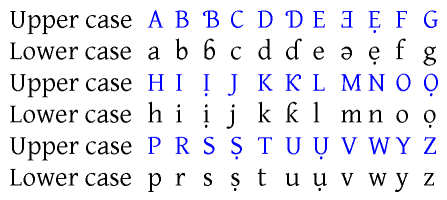Pan-Nigerian alphabet
The Pan-Nigerian alphabet is a set of 33 Latin letters standardized by the National Language Centre of Nigeria in the 1980s. It is intended to be sufficient to write all the languages of Nigeria without using digraphs.
History
Several hundred different languages are spoken in Nigeria. The different Latin alphabets impeded the use of typewriters. In the 1980s the National Language Centre (NLC) undertook to develop a single alphabet suitable for writing all the languages of the country, taking as its starting point a model proposed by linguist Kay Williamson in 1981. The final version and reference typeface were developed by the typographer Hermann Zapf in 1985.
Characters

If you have a Unicode font installed with the Pan-Nigerian glyphs then you should see an identical table below:
| Upper case | A | B | Ɓ | C | D | Ɗ | E | Ǝ | Ẹ | F | G |
| Lower case | a | b | ɓ | c | d | ɗ | e | ǝ | ẹ | f | g |
| Upper case | H | I | Ị | J | K | Ƙ | L | M | N | O | Ọ |
| Lower case | h | i | ị | j | k | ƙ | l | m | n | o | ọ |
| Upper case | P | R | S | Ṣ | T | U | Ụ | V | W | Y | Z |
| Lower case | p | r | s | ṣ | t | u | ụ | v | w | y | z |
The acute ( ´ ), grave ( ` ) and circumflex ( ˆ ) accents are also used to mark High, Low, and Falling tone respectively. Mid tone (in languages which contrast High, Mid, and Low) is left unmarked.
Keyboard
The following typewriter keyboard was produced for the NLC by Olivetti[1]:
| ˆ ˊ |
" 2 |
/ 3 |
− 4 |
₦ 5 |
= 6 |
_ 7 |
ǀ 8 |
( 9 |
) ? |
Ɗ |
Ƙ |
⌫ Backspace | ||||||||||||||||||||||||||||||||||||||||||||||||
| ↹ Tab | ˉ ˋ |
W |
E |
R |
T |
Y |
U |
I |
O |
P |
Ụ |
Ị |
||||||||||||||||||||||||||||||||||||||||||||||||
| ⇫ Caps Lock | A |
S |
D |
F _ |
G |
H |
J _ |
K |
L |
Ọ |
Ẹ |
Ǝ |
||||||||||||||||||||||||||||||||||||||||||||||||
| ⇧ Shift | Z |
Ɓ |
C |
V |
B |
N |
M |
; , |
: . |
Ṣ |
⇧ Shift | |||||||||||||||||||||||||||||||||||||||||||||||||
| Ctrl | ⊞ | Alt | Space bar | Alt Gr | Fn | ≡ | Ctrl | |||||||||||||||||||||||||||||||||||||||||||||||||||||
On this typewriter keyboard layout the letters Q and X were not mapped as they were not part of the alphabet, and digits 0 or 1 had to be entered as capital letters O and I. And keys in gray (for modern computers) were missing.
On modern keyboard for computers, the distinctive digits 0 and 1 are placed on the unshifted positions of keys of first row (like other digits), the letter Q is mapped like on standard QWERTY layouts, but dead keys at start of the first and second row need to be moved to the 102th key on start of the first row (reducing the width of the left shift key), and to the shifted position of the new key assigned to digit 0 on the first row.
In all cases, the Enter key may vary between this L-shaped key on two rows, and the horizontal key on the third row only (moving the key assigned to letter Ǝ to the end of the second row).
Notes and references
- ↑ Pan-Nigerian Typewriter Design, archived